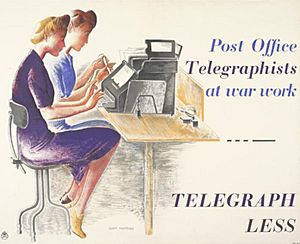Donia Nachshen facts for kids
Quick facts for kids
Donia Nachshen
|
|
|---|---|
| Born |
Donia Esther Nachshen
22 January 1903 |
| Died | 1987 (aged 83–84) |
| Nationality | British |
| Education | Slade School of Fine Art |
| Known for | Illustration and poster art |
Donia Esther Nachshen (born January 22, 1903 – died 1987) was an artist born in Ukraine who later became a British citizen. She was known for illustrating books and designing posters. Today, she is most famous for the posters she created for the British government during World War Two.
Donia's Early Life and Art Training
Donia Nachshen was born in a city called Zhitomir. At that time, Zhitomir was part of Russia, but it is now in Ukraine. Donia came from a Jewish family. In 1905, there were violent attacks against Jewish people in the city. Because of this, her family left Zhitomir and eventually moved to London, England.
Donia did very well in school in London. She then went on to study art at the famous Slade School of Art. By the 1920s, she had become a successful book illustrator. She drew pictures for translated books by famous writers like Arthur Schnitzler and Anatole France, who won a Nobel Prize. Her art style was inspired by traditional Russian folk art and the popular Art Deco movement.
Donia also illustrated a special Jewish text called the Haggadah in 1934. She also created drawings for books by well-known authors such as Oscar Wilde and Samuel Butler. You might have also seen her illustrations in the Radio Times magazine.
Art During World War Two
During World War Two, Donia Nachshen designed posters for important government campaigns. One famous campaign was called Make Do and Mend, which encouraged people to repair old items instead of buying new ones. She also designed posters for the Telegraph Less campaign, which asked people to send fewer telegrams to save resources.
Even during the war, she continued to illustrate books. She drew pictures for Diary of a Madman by Nikolai Gogol and a collection of short stories by Fyodor Dostoyevsky in 1945. She also illustrated books for children, including some by the popular author Enid Blyton.
After the war, Donia lived in London. She kept illustrating Russian novels and poetry for publishers like Constable & Co and Lindsay Drummond. For the Russian novels, she used a special drawing technique called scraperboard. This technique creates dramatic pictures that look a bit like old Eastern European woodcuts. For the children's books she illustrated, she used lighter pen drawings.
Books Donia Illustrated
Here are some of the books Donia Nachshen illustrated:
- The Works of Anatole France by Anatole France, (Bodley Head, 1925)
- Topsy Turvey by V. Bartlett, (1927)
- Rhapsody by Arthur Schnitzler, (Constable, 1928)
- Fraulein Else by Arthur Schnitzler, (Constable, 1929)
- The Red Lily by Anatole France, (Bodley Head, 1930)
- The Haggadah (1934)
- The Way of All Flesh by Samuel Butler, (Cape, 1936)
- Enid Blyton's Nature Lover's Book by Enid Blyton, (Evans Brothers, 1944)
- Black Night, Red Morning by Geoffrey Trease, (1944)
- Diary of a Madman / Nevsky Prospekt by Nikolai Gogol, (Drummond, 1945)
- Three Tales by Fyodor Dostoyevsky, (Drummond, 1945)
- The Spirit of Music by Alexander Blok, (Drummond, 1946)
- Tales of Bielkin by Alexander Pushkin, (Drummond, 1947)
- Pushkin, Lermontov, Tyutchev; Poems (Drummond, 1947)
- Out of Childhood by I. Odoertzera, (Constable)
- Poems in Prose by Ivan Turgenev, (Drummond)


